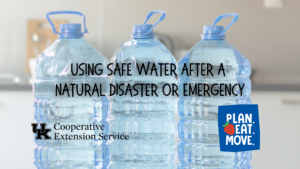If you are in a disaster or emergency, you must take steps to prevent illness from unsafe water.

After a disaster:
- Do not use water you suspect or have been told is contaminated to drink, wash dishes, brush your teeth, wash and prepare food, wash your hands, make ice, or make baby formula
- Use bottled, boiled, or treated water for drinking, cooking, and personal hygiene
- Follow your state, local, or tribal health department for specific recommendations regarding boiling or treating water in your area.
- Avoid drinking alcohol as it dehydrates the body, which increases the need for drinking water.
Never use water from unsafe sources
After an emergency or flooding, drinking water may not be available or safe to drink. Never use water from radiators or boilers that are part of your home system.
Do not use water you suspect or have been told is unsafe to:
- Wash Dishes
- Brush teeth
- Wash and prepare food
- Make Ice
- Make baby formula
Contaminated Well Water
Drinking water walls can be damaged due to floods and other disasters which lead to aquifer and well contamination. Drinking water wells can be contaminated due to floodwater with livestock waste, human sewage, chemicals, and other contaminants. Drinking contaminated well water can lead to illness as well as using the water for bathing and other hygiene activities.
- It is safest to drink bottled water until you are certain your water is free of contaminants and safe to drink.
- If you suspect your drinking well water is contaminated DO NOT drink the water.
- Contact your local, state, or tribal health department for specific advice on wells and testing.
Methods for Making Water Safe to Use
Boiling Water:
- The surest method to make water safe to drink by killing disease-causing organisms, including viruses, bacteria, and parasites.
Steps for Boiling Cloudy Water:
- Filter it through a clean cloth, paper towel, or coffee filter, OR allow it to settle.
- Draw off the clear water.
- Bring the clear water to a rolling boil for 1 minute (at elevations above 6,500 feet, boil for 3 minutes).
- Let the boiled water cool.
- Store the boiled water in clean, sanitized containers with tight covers.
Steps for Boiling Clear Water:
- Bring the clear water to a rolling boil for 1 minute (at elevations above 6,500 feet, boil for 3 minutes).
- Let the boiled water cool.
- Store the boiled water in clean, sanitized containers with tight covers.
Disinfectants:
- Using a unscented household chlorine bleach, iodine, or chlorine dioxide tablet can often make water safer to drink as they kill most harmful organisms, such as viruses and bacteria.
- Only chlorine dioxide tablets are effective in controlling more resistant organisms, such as the parasite
- Make sure to know the concentration of bleach you are using, it should be found on the label.
Steps for Disinfecting Water Using Bleach:
- If your water is cloudy, filter water through a clean cloth, paper towel, or coffee filter, OR allow it to settle, then draw off the clear water and follow the steps below.
- Follow the instructions on the bleach label for disinfecting drinking water.
- If the necessary instructions are not given, add a little less than 1/8 teaspoon (8 drops or about 0.5 milliliters) bleach for each gallon of clear water (or 2 drops of bleach for each liter or each quart of clear water).
- Stir the mixture well.
- Let it stand for at least 30 minutes before using.
- Store the disinfected water in clean, sanitized containers with tight covers.
Steps for Disinfecting Water using Chlorine Dioxide Tablets:
- Follow the manufacturer’s instructions.
- Store the disinfected water in clean, sanitized containers with tight covers.
Steps for Disinfecting Water using Filters:
- Many portable water filters can remove disease-causing parasites such as Cryptosporidium and Giardia from drinking water.
- If you are choosing a portable water filter, try to pick one that has a filter pore size small enough to remove both bacteria and parasites (absolute pore size of 1 micron or less). Most portable water filters do not remove bacteria or viruses.
- Carefully read and follow the manufacturer’s instructions for the water filter. After filtering, add a disinfectant such as iodine, chlorine, or chlorine dioxide to the filtered water to kill any viruses and remaining bacteria.
References: https://www.cdc.gov/disasters/foodwater/safe-water.html
Source: Jessica Hantle, Dietetic Intern; Jeanie Najor, RDN, MS, Nutrition Extension Specialist


Find more CDC safe water tips here: CDCSafeWater
https://www.cdc.gov/healthywater/emergency/making-water-safe.html